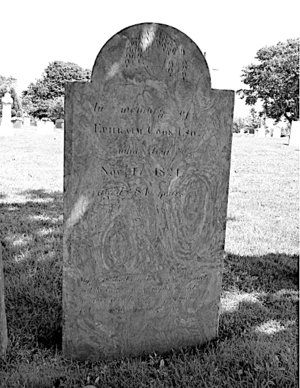Ephraim Cook (mariner) facts for kids
Ephraim Cook (born June 1, 1737, in Kingston, Massachusetts – died November 17, 1821, in Rockville, Nova Scotia) was an important sailor and businessman. He played a big part in starting several communities in Nova Scotia, like Halifax, Mahone Bay, Blockhouse, and Chebogue, Nova Scotia. Cook also served in the French and Indian War, which included the difficult event known as the Expulsion of the Acadians. He was the very first Registrar of Deeds (a person who keeps records of property) in 1767 and the first Justice of the Peace (a local judge) in Yarmouth County.
Contents
Ephraim Cook's Early Life and Adventures
Ephraim Cook started his career as a mariner, meaning he was a skilled sailor. His adventures began early, helping to shape new settlements in what would become Canada.
Helping to Settle Halifax
In 1749, Cook was the captain of a ship called the Baltimore. He helped transport 255 settlers to start the city of Halifax. This was part of an expedition led by Edward Cornwallis. Later, Cook had some disagreements with Cornwallis and faced consequences for speaking out.
Role in the French and Indian War
Five years later, during the French and Indian War, Cook continued to be active.
Founding Mahone Bay
In 1754, Cook helped establish the community of Mahone Bay. This settlement was protected by Captain Thomas Lewis (mariner) and his group of rangers. Cook also built the first ship in Mahone Bay, a type of ship called a snow, named the Edward.
Journey with Acadians
In 1755, Captain Cook was again in charge of the ship Edward. On December 8, 1755, his ship departed from Annapolis Royal, Nova Scotia with 278 Acadians. The Acadians were being moved from their homes. The ship faced terrible storms and was blown off course, finally arriving in New London, Connecticut, on May 22, 1756. Sadly, 98 Acadians (about 35%) died during the long journey due to illness.
Building Protection in Blockhouse
After an attack on Lunenburg in 1756, Cook built a strong blockhouse to protect Mahone Bay. This blockhouse was located in what is now the community of Blockhouse. During its construction, Cook was injured and lost a leg. After his injury, he returned to Massachusetts for a time.
Advocating for an Assembly
In 1757, Cook, along with Joshua Mauger, encouraged Governor Charles Lawrence to create an elected assembly. This assembly would allow people to have a say in their government.
Establishing New Communities
Ephraim Cook was a true pioneer, not only helping to establish major towns but also creating new settlements and industries.
Settling Chebogue and Lower Melbourne
In 1763, Cook played a key role in establishing Chebogue. He was also the first person to settle Lower Melbourne, Nova Scotia. A nearby place, Cooks Beach, is named after him.
Developing the Fishing Industry
Cook was very successful in business. He started the most profitable fishing industry in Western Nova Scotia, which helped the region grow. He was also the leader of the local militia, a group of citizens who could act as soldiers if needed.
Family and Final Years
Ephraim Cook married Louisa Ring on March 30, 1764. They had eleven children together. Captain Cook passed away in 1821. He was buried on his farm in Lower Melbourne, but his headstone, which marks his grave, is located in the Chebogue Cemetery.
Legacy
- Namesake of Cooks Beach (Nova Scotia) and Cook Harbor, both in Yarmouth County.


